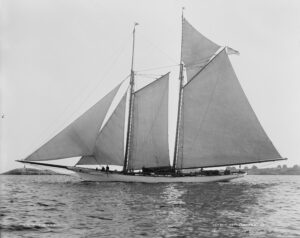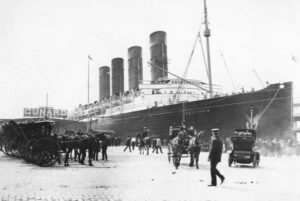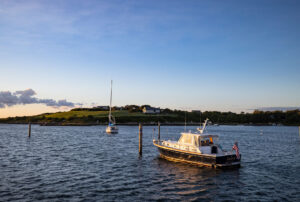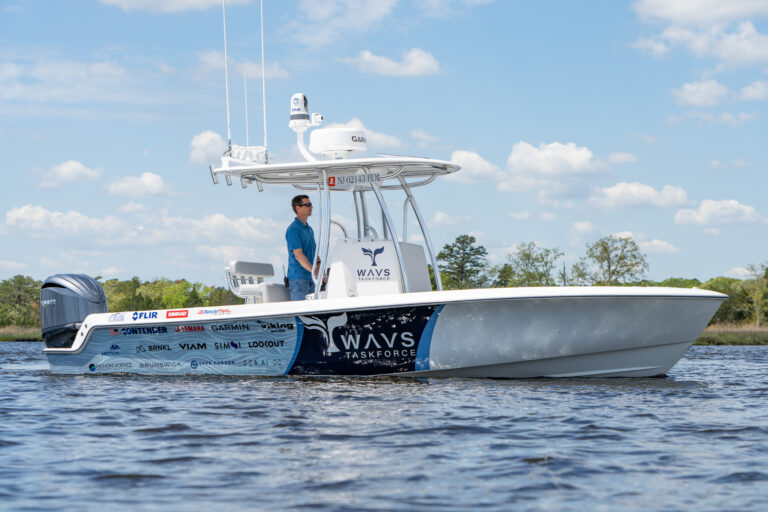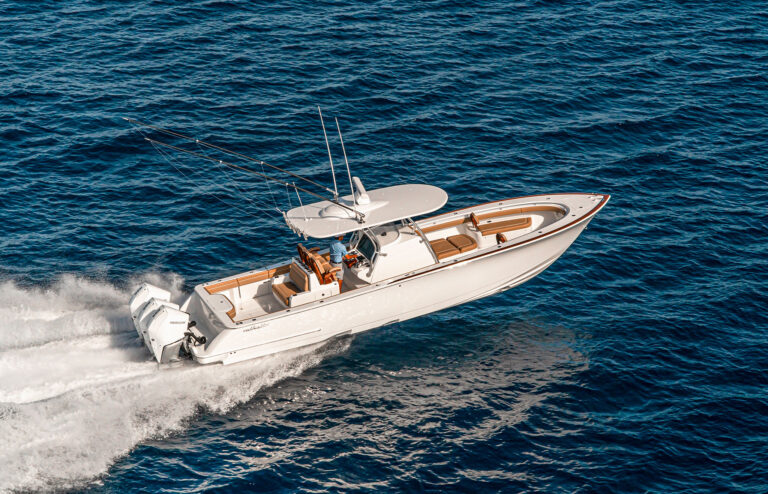Bluenose, Canada’s most famous schooner, made its mark almost a century ago fishing and racing in the Atlantic off Nova Scotia. Today, a direct cousin of Bluenose is still sailing off Canada’s other coast, in the Pacific Northwest: Passing Cloud.

Bluenose was the 17th William Roué design, and he went on to create more than 100 commercial vessels and yachts. One of them (No. 165 in his portfolio) was Passing Cloud, but Roué did not live to see her sail. She wasn’t built until 1974, almost 30 years after he drew it and four years after he died at age 90.
Blame it on bureaucracy. Roué designed the boat for a 1945 contest sponsored by the new United Nations Relief and Rehabilitation Administration as part of a program to help China recover from World War II. The design was to provide a simpler, stronger and short-handed alternative to the Chinese junk to revitalize coastal fishing and freighting.
Roué’s plan won the design contest, but the agency dissolved two years later without financing a single boat. The drawings sat for almost three decades until Brian Walker, a commercial boatbuilder in Victoria, British Columbia, dusted them off to build a yacht he and his wife could sail around the world — the only boat ever built to Roué’s award-winning design.
Smaller, tough and fast

At 70 feet overall and 50 tons displacement, Passing Cloud is less than half the size of Bluenose, at 143 feet and 128 tons. However, similarities between the two are unmistakable. Both share the clean, beautiful lines of a classic wooden schooner — two masts, sails fore and aft, with both the main and fore mast stepped nearly amidships. Both were designed for strength and functionality to excel in heavy weather. And both proved fast, especially in powerful winds.
Bluenose won all of its four contests against the best U.S. boats in the International Fisherman’s Trophy Race from 1921 to 1938. Passing Cloud, very fast to windward, dominated schooner races up and down the West Coast in the 1980s and won the 1984 Master Mariners Heritage Race in San Francisco — the only Canadian boat to win that event. Mounted in the boat’s wheelhouse are 36 brass plaques of race and heritage show awards. (For more on Bluenose, search “Rebirth of an Icon” at www.SoundingsOnline.com.)
A boatbuilder’s boat
As a commercial builder, Walker had the skills to modify Passing Cloud to his tastes. It took him five years to collect the white oak for the boat’s frames because much of that hard and popular wood is used for furniture and whiskey barrels. He eliminated the bowsprit and changed the original gaff rig to a Marconi rig to simplify sail handling. Walker also designed and built the hydraulic windlass still used to handle thousands of pounds of chain and ground tackle. A striking stainless steel boomkin, arching up off the stern, raises the aft rigging off the deck and supports the massive main boom.
Walker’s most dramatic change to the Roué design is a classic West Coast pilothouse amidships, with a 180-degree view, to protect the helmsman from the rainy, cold and blustery weather of the Pacific Northwest. (A second steering station at the stern is used in good weather.) The pilothouse, gleaming with brass, has a spacious chart table, galley and dining area, and dry access to the stern cabin below deck.
The masts were cut from a single 71-foot Sitka spruce, and the rig can carry as much as 4,000 square feet of sail, spread among the main (1,000 square feet), foresail, two genoas, and large and small topsails. Part of the beauty of the schooner design is that the sail plan can be balanced for the conditions. On my trip, under occasional near-gale conditions, just the foresail and genoa drove the boat fast and comfortably.
The decking is 2-inch-thick Burmese teak recycled from a legendary British Columbia coastal steamer, the SS Cardena, scrapped in 1958. Below, the spacious and comfortable saloon of red and yellow cedar exudes warmth from new paint and varnish and a cast-iron diesel stove, brightened by natural light from a big hatch. Three private cabins — each with hot-and-cold water vanities and fluffy duvets — are off the saloon, with additional guest quarters in the aft cabin (two double berths) and crew quarters in the fo’c’sle. There are two heads.
A 6-cylinder 140-hp Volvo drives the boat as fast as 10 knots, and with 1,600 gallons of fuel, Passing Cloud has a cruising range of as much as 9,000 miles. The engine room, directly below the deckhouse, is big enough for a built-in workbench. Three-inch-thick cedar bulkheads divide the hull into five watertight compartments, and the boat exceeds Transport Canada standards for stability and safety. Passing Cloud is certified to carry as many as 14 overnight passengers but typically carries eight guests and four crewmembers.

For a 40-year-old wooden boat, her hull is remarkably tight, quiet and leak-free, a testament to the quality of Walker’s construction. As a 2012 survey noted, Passing Cloud “is constructed from exceptional materials, is exceptionally well-built and is exceptionally well-maintained.”
Her new life
After Walker and his wife retired from sailing, they sold Passing Cloud to another resident of Victoria, who put the boat into sail training. That role has been continued by the boat’s current owner, Russell Markel, a marine biologist from Victoria who bought the boat in 2012 for his Outer Shores Expeditions (outershores.ca). He provides weeklong liveaboard “soft adventure” expedition cruises and for-credit educational programs through the Gwaii Haanas National Park Reserve and several other coastal wilderness areas in British Columbia.
Markel has an ideal background for leading trips such as this, beyond the fact that he grew up here and has spent years diving and doing research. For nine years, he spent summers leading eco-tours throughout Gwaii Haanas National Park as captain of a similar sailboat, Island Roamer. In addition to being a patient and natural teacher, he tries to inspire others with his passion for this region’s unspoiled nature and the importance of protecting it — “sailing with a purpose,” as he calls it.
“When I saw this boat, I fell in love with it,” Markel says, “not just for what it was but for what it could allow me to do.”
See related articles:
– The Haida canoe and the Vikings of the Pacific Northwest
March 2015 issue


